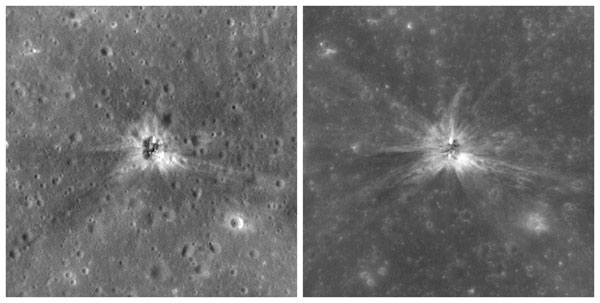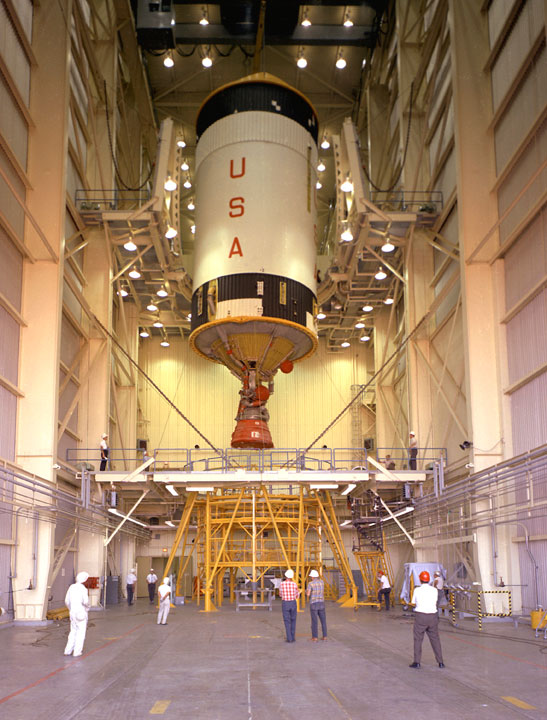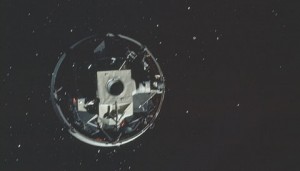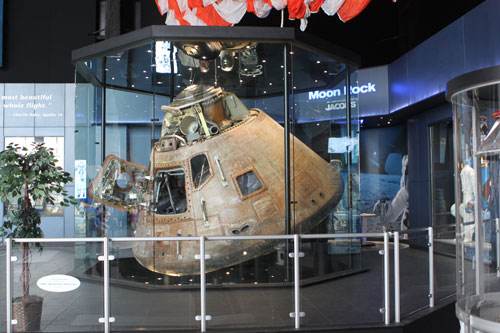The Lunar Reconnaissance Orbiter has finally spotted the impact of the Apollo 16 booster on the Moon, more than 43 years after it happened.

NASA / LRO
Eagle-eyed sleuths have finally solved a long-standing mystery from the Apollo era. Last month, researchers poring over Lunar Reconnaissance Orbiter (LRO) images identified the impact site of the Apollo 16 S-IVB stage booster. The discovery completes the search for the impact sites of Apollo-era rocket boosters.
LRO has spied human artifacts on the lunar surface many times before, including the final resting place of the recent GRAIL-A and -B probes Ebb and Flow, the Apollo landing sites, and artifacts going all the way back to the early Ranger missions.

NASA
But locating the Apollo 16 booster impact site has always posed a dilemma. Directed to impact the Moon shortly after jettison on April 19, 1972, engineers prematurely lost contact with the Apollo 16 booster. As a result, uncertainty on the time of impact lingered, by about four seconds.
That may not sound like a lot, but LRO found the impact site 30 kilometers (18.6 miles) from original estimates. The four other booster impacts lay within 7 km of their estimated locations. The Apollo 16 S-IVB booster impacted the lunar surface in Mare Insularum, 260 km southwest of the prominent Copernicus crater.
A History of Lunar Crashes
Over the span of six missions, NASA directed five boosters and four discarded lunar modules to impact the Moon. These were deliberate crashes, and the seismic monitoring stations that astronauts had left behind on the Moon felt the tremors caused by the impacts. It's worth noting that all five lunar landings and impact sites occurred along the Moon's equatorial zones on the lunar near side for line-of-sight communication with mission controllers on Earth.
Lots of human-made artifacts had struck the Moon before and after that, starting with Luna 2 on September 12, 1959. The same rocket that launched LRO on June 18, 2009, also delivered the Lunar Crater Observation and Sensing Satellite (LCROSS) mission into lunar orbit. In search of water frozen in craters that never see the Sun, LCROSS struck down near Cabeus crater in the lunar south pole region on October 9, 2009.

NASA

James E. Scarborough / Wikimedia Commons
Apollo 16 launched on April 16, 1972, and was the fifth crewed mission to land on the Moon. Its S-IVB booster crashed onto the Moon with just slightly less force than a detonation of the U.S. Air Force's Massive Ordinance Air Blast Bomb. The blast left a small crater 40 by 30 meters wide, festooned with fresh, brilliant rays. Spent of their fuel, the low-speed, low-mass boosters leave somewhat unusual craters compared to space rocks — LRO Principal Investigator Mark Robinson likens a booster impact to “an empty soda can” striking the Moon's surface.
Studying the impact sites can help researchers understand how the resulting craters and rays fade over time. And finding the impact sites will go a long way toward interpreting seismic data gathered by the lunar monitoring stations.
Understanding ‘moonquakes’ and actions within the lunar interior may prove vital to future long-duration Moon missions, which would require moonquake-proofed structures. To this end, scientists have called for a new series of seismic stations on the Moon to probe additional regions, including the lunar poles and the far side.
Finding the final resting place of the Apollo 16 booster closes a space-age mystery, and represents another great find by LRO.
Want to scour the lunar surface for yourself? Check out the CosmoQuest Moon Mappers project.
 7
7
Comments
January 12, 2016 at 11:21 pm
The articles mention that five of the six posters crashed into the moon, and full of the six lunar modules crashed into the moon. I have always wondered what happened to the booster that did not crash into the moon. And I am especially interested in the two lunar modules that did not crash into the moon. Where are they, relatively speaking?
You must be logged in to post a comment.
January 13, 2016 at 2:57 pm
Still orbiting the moon?
You must be logged in to post a comment.
Corey Rueckheim
January 14, 2016 at 2:43 pm
The Eagle (Apollo 11) and the Orion (Apollo 16) were left in lunar orbit, but their orbits decayed and they eventually crashed on the lunar surface as well. Only Snoopy, from Apollo 10, remains in space - in orbit somewhere around the Sun (searches for it have not yet been successful).
Wikipedia also says that the S-IVB boosters from Apollo 8, 9, 10, 11, and 12 were all left in heliocentric orbit. But look up "J002E3" for some interesting information about Apollo 12's booster.
You must be logged in to post a comment.
Bob Bickers
January 15, 2016 at 11:21 pm
At first I found it hard to believe that the Apollo 9 S-IVB was in heliocentric orbit considering the mission was conducted entirely in low earth orbit. But in fact, after achieving earth orbit, the Apollo 9 lunar module was extracted, and then the third stage booster was re-ignited, sending the S-IVB out of the Earth-moon system. In lunar-bound missions, the lunar module would have been extracted after the second burn out of earth orbit. Does that mean that a third burn would have driven the other S-IVBs into the moon, or did they drift to impact based solely on their trajectory?
You must be logged in to post a comment.
Corey Rueckheim
January 16, 2016 at 5:28 am
Two Auxiliary Propulsion System (APS) pods, one on either side of the S-IVB, contained engines used for several purposes, one of which was to put the S-IVB on a trajectory to impact the moon. See the specific Apollo 16 event at 005:40:07.2 on the Apollo Mission Timeline.
For some more information about the APS, visit Saturn S-IVB Auxiliary Propulsion System Engines and S-IVB - Wikipedia.
You must be logged in to post a comment.
January 16, 2016 at 10:41 am
Picture Caption: "The Apollo 16 Command Module — the only segment of an Apollo mission that returned to Earth — is on display at the U.S. Space and Rocket Center in Huntsville, Alabama."
All of the manned Command Modules returned to earth!
You must be logged in to post a comment.
Scawtee
March 5, 2018 at 2:25 pm
I know this is an old thread but I am amazed there is no conspiracy theorists clogging this up, unless its been weeded. Good article, thanks.
You must be logged in to post a comment.
You must be logged in to post a comment.